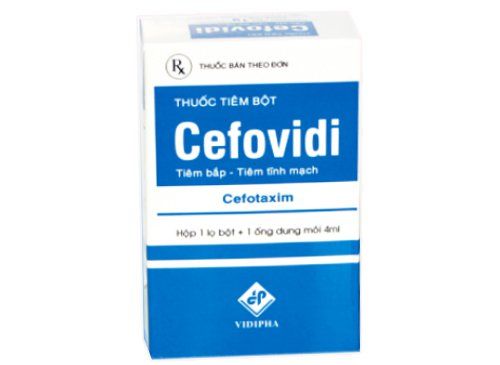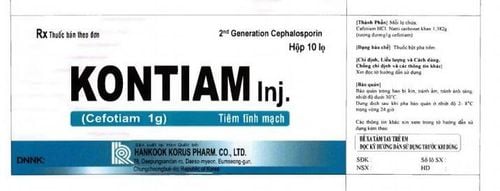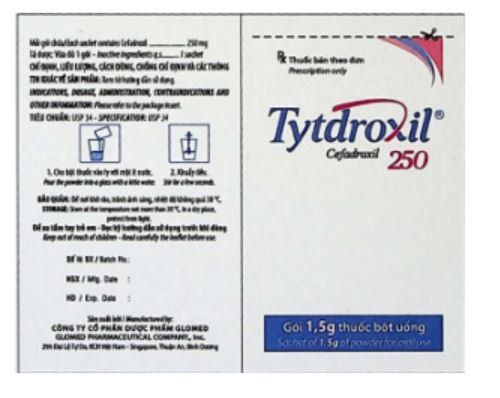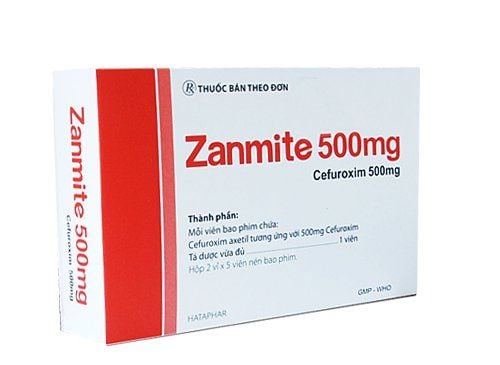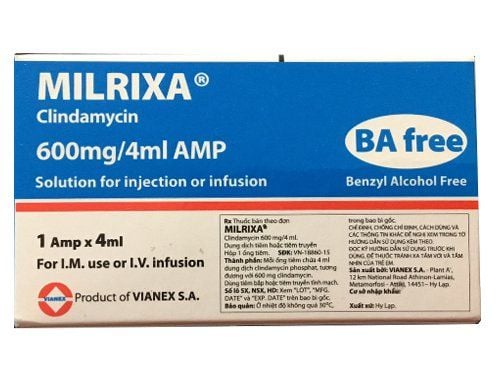This is an automatically translated article.
Nakai contains the main ingredient is Clindamycin with a concentration of 300mg. The drug is in the form of capsules and is indicated for the treatment of body infections. Before using Nakai, patients should consult their doctor for advice and instructions. The following is some information to help patients understand what Nakai medicine does? What is the dosage?
1. Uses of the drug Nakai
The ingredient Clindamycin in Nakai is an antibiotic belonging to the Lincosamide family. The drug inhibits protein synthesis of bacterial cells by inactivating their ribosomes. At low concentrations, Nakai has a bacteriostatic effect. At high concentrations, Nakai has the effect of killing bacteria. However, at present, bacteria also have a mechanism of resistance to drugs belonging to the Clindamycin strain, this type of resistance is usually mediated by Plasmids.On the other hand, the macrolide antibiotics also work on the same site of bacteria with clindamycin, so there is cross-resistance between these two groups of antibiotics. The Clindamycin Phosphate form is inactive in vitro but hydrolysis in Vivo alone yields the active compound. One of the enzymes capable of this is Phosphatase present in the skin.
1.1 Indications of the drug Nakai Drug Nakai is indicated to treat the following cases:
Infection in the abdomen. Sepsis . Inflammation of the respiratory tract. Lung abscess caused by Pneumococcus, Staphylococcus or Streptococcus. Prophylaxis of endocarditis due to infections caused by surgical transplantation in patients with penicillin hypersensitivity or long-term treatment with penicillin. Severe infections of the pelvis or genital tract such as: tubal abscess not caused by gonococcal bacteria, endometritis, post-operative vaginal infection caused by anaerobic bacteria, ... Infection of the wound with pus after surgery or trauma. 1.2 Contraindications of the drug Nakai Patients should not take Nakai if:
There is a history of hypersensitivity to the components of the drug Nakai, especially to Lincomycin or Clindamycin. Having diarrhea.
2. Dosage and how to take Nakai
Dosage:
For cases of bacterial infection:
For adults: From 150-300mg, 6 hours apart each time. In severe cases, the dose can be increased to 450mg. For children > 1 year: From 3-6mg/kg, every 6 hours. For children < 1 year old or weighing less than 10 kg, should use Nakai oral solution, 37.5mg each time, every 6 hours. Prophylaxis of endocarditis:
Dose of 600mg or 10mg/kg body weight, 1-2 hours before surgery. Or 6 hours after surgery at a dose of 300mg or 5mg/kg. How to use: Patients take Nakai orally, with a full glass of water.
Note: The above Nakai dosage is for reference only. The specific dose of Nakai depends on the condition and the progression of the disease. To get the right dose of Nakai, patients should consult their doctor or medical professional.
3. Side effects of the drug Nakai
At therapeutic doses, Nakai is well tolerated. However, the process of using Nakai, patients may still experience side effects such as:
Pseudomembranous colitis with symptoms such as diarrhea, fever, abdominal pain, mucus and blood in the stool. You jute. Esophagitis ; Anaphylaxis ; Eosinophilia increased; Neutropenia ; Increased recovery of liver enzymes. The effects of Nakai are usually not serious and are of moderate severity. However, serious side effects of Nakai can still occur, so do not be subjective. If you experience these symptoms, the patient should stop using Nakai and notify the doctor for appropriate treatment.
4. Drug interactions Nakai
Nakai may have an interaction reaction if used concurrently with:
Steroid contraceptives; Erythromycin drug ; Kaolin-Pectin Suspension; Substances that reduce intestinal motility. To avoid interactions, before being prescribed Nakai, the patient should inform the doctor about the drugs they are using, including functional foods. The doctor will base on that to prescribe the appropriate Nakai.
5. Notes when using and storing Nakai
Should be used with caution when using Nakai for people with gastrointestinal disease or a history of severe hypersensitivity. For patients who need long-term treatment, young children and people with impaired liver and kidney function, it is recommended to periodically check liver and kidney function. Nakai is a prescription drug, used only with a prescription from a doctor. Patients should carefully read the instructions for use of Nakai medicine before using. Pregnant and lactating women should not take Nakai. If you experience symptoms that are suspected to be caused by an overdose of Nakai, the patient should stop using it and immediately go to a medical facility for timely treatment. Store Nakai medicine at room temperature, below 25 degrees Celsius and avoid direct light from the environment. The article has provided information on dosage, contraindications and notes during the use of Nakai drug. To ensure optimal effects of Nakai and prevent side effects, patients should consult their doctor or pharmacist before use.
Please dial HOTLINE for more information or register for an appointment HERE. Download MyVinmec app to make appointments faster and to manage your bookings easily.




